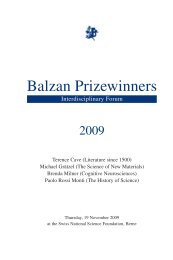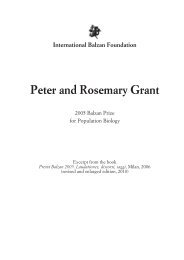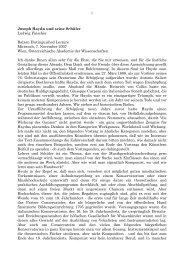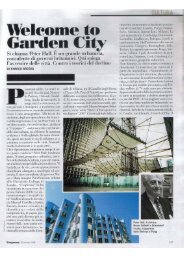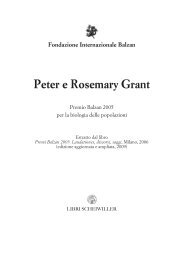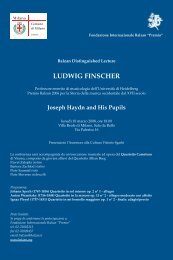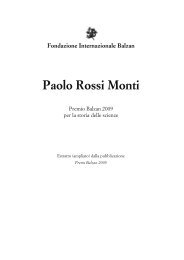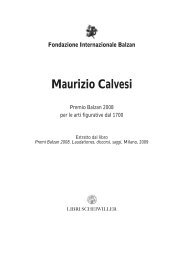Russell J. Hemley and Ho-kwang Mao
Russell J. Hemley and Ho-kwang Mao
Russell J. Hemley and Ho-kwang Mao
You also want an ePaper? Increase the reach of your titles
YUMPU automatically turns print PDFs into web optimized ePapers that Google loves.
2005 Balzan Prize<br />
Pressure-induced amorphization began to be reported in a broad range of materials,<br />
as other groups began to study the effect. A major problem in this work<br />
was associated with an inability to probe the materials over a sufficient range of<br />
length scales <strong>and</strong> with the lack of in situ techniques. This problem was solved in<br />
a series of microscopy studies carried out with Kathleen Kingma; these studies<br />
directly revealed the range of length scales associated with the transformation<br />
[Science 259, 666 (1993)], the existence of a metastable intermediate phase [Phys.<br />
Rev. Lett. 70, 3927 (1993)] <strong>and</strong> the complexity of the proposed glasses formed<br />
in this way [Phys. Rev. Lett. 72, 1302 (1994)]. The existence of an intermediate<br />
phase remained the subject of a great deal of subsequent theoretical papers by<br />
condensed matter theorists. Brillouin scattering measurements confirmed the<br />
elastic instability hypotheses for quartz specifically [Phys. Rev. Lett. 84, 3117<br />
(2000)]. Pressure-induced amorphization is now documented in a broad range<br />
of materials; in addition to the novel dynamical aspects of the problem, it offers<br />
a new route for the synthesis of new materials with novel physical properties. 34<br />
The work on amorphization led to the discovery of new phenomena in related<br />
systems. The observation of amorphization of ice mentioned above had been reported<br />
using quench techniques. <strong>Ho</strong>wever, the transformation was not monitored<br />
directly; hence numerous questions remained with regard to the actual<br />
transformation, including its mechanism. Using newly developed in situ techniques,<br />
the transition sequence was directly observed <strong>and</strong> monitored by optical<br />
spectroscopy for the first time [Nature 338, 638 (1989)]. The study revealed the<br />
mechanism of the transformation, proof that the high-pressure phase was indeed<br />
amorphous <strong>and</strong> the pressure-temperature limits of high-density amorphous ice.<br />
Moreover, this exhaustive study revealed that this fundamentally important system<br />
– H 2O – is far richer than previously anticipated, revealing numerous new<br />
<strong>and</strong> unexpected transformations as a function of pressure <strong>and</strong> temperature. Aspects<br />
of this work were confirmed by others working in this field much later, including<br />
neutron studies carried out in the early 1990s, 35 as well as in very recent<br />
research. 36 In later work, another class of metastable transformations was revealed<br />
through these spectroscopic techniques [Science 281, 809 (1998)]. Together<br />
with the later higher pressure studies transformations discussed below<br />
[Science 273, 218 (1996); Phys. Rev. Lett. 78, 4446 (1997)], the work continues<br />
a tradition of study of the wonders of water <strong>and</strong> ice begun by Gustav Tammann 37<br />
<strong>and</strong> Percy W. Bridgman 38 over a century ago. 39<br />
18



